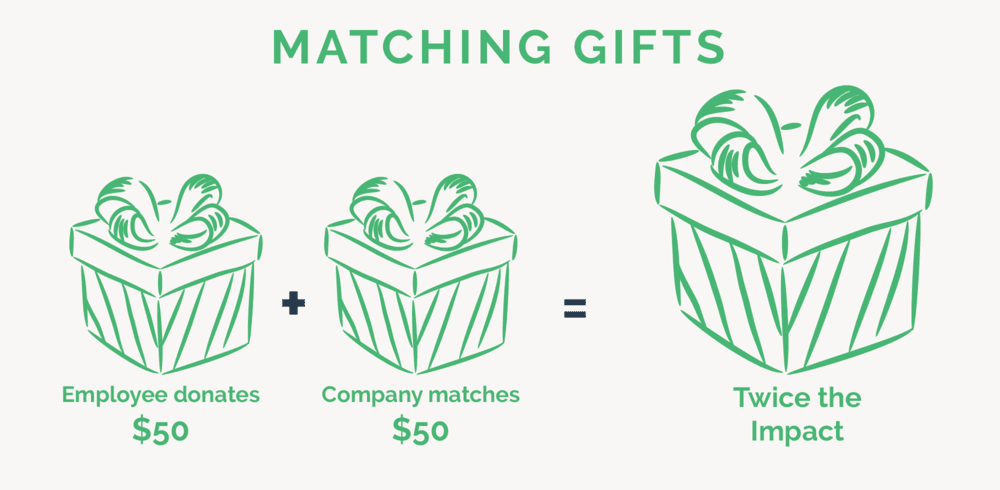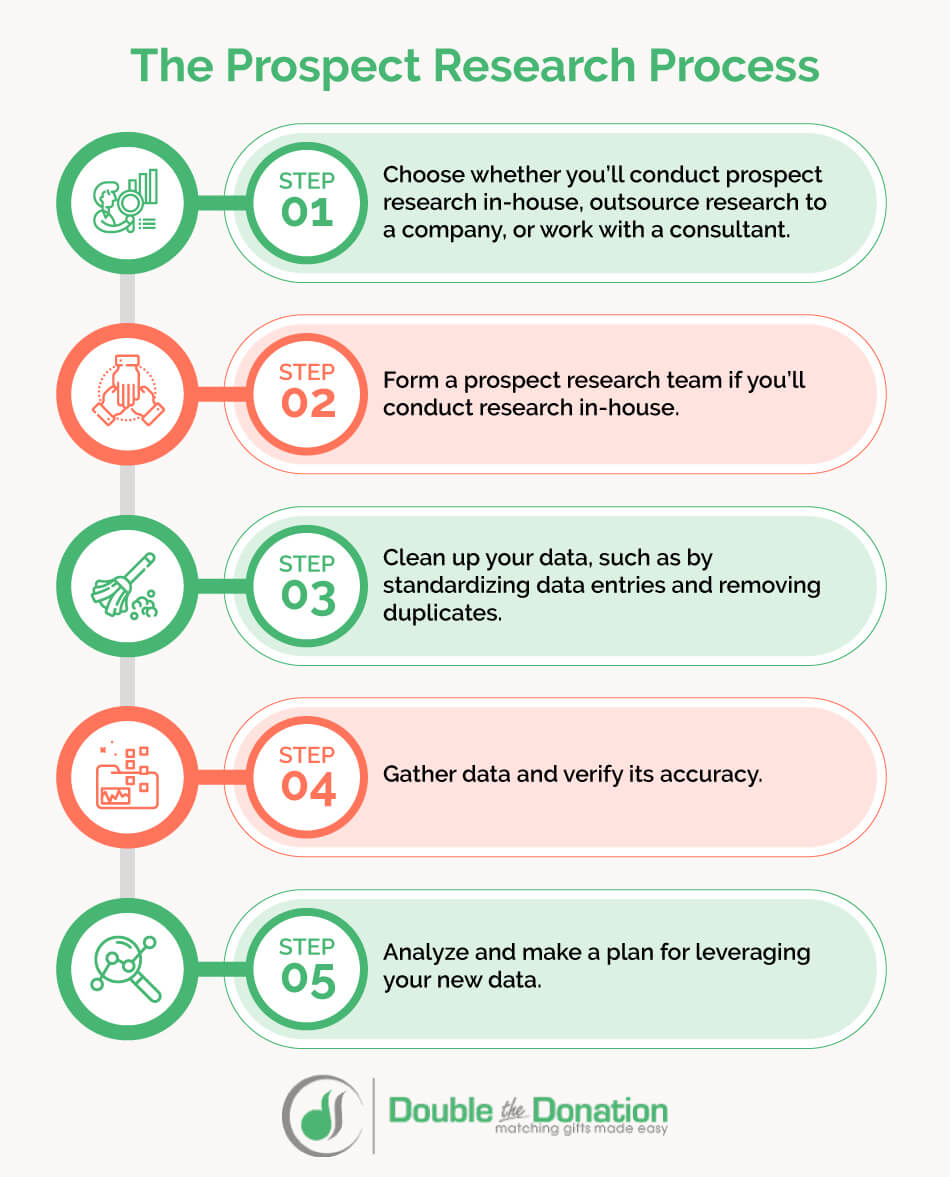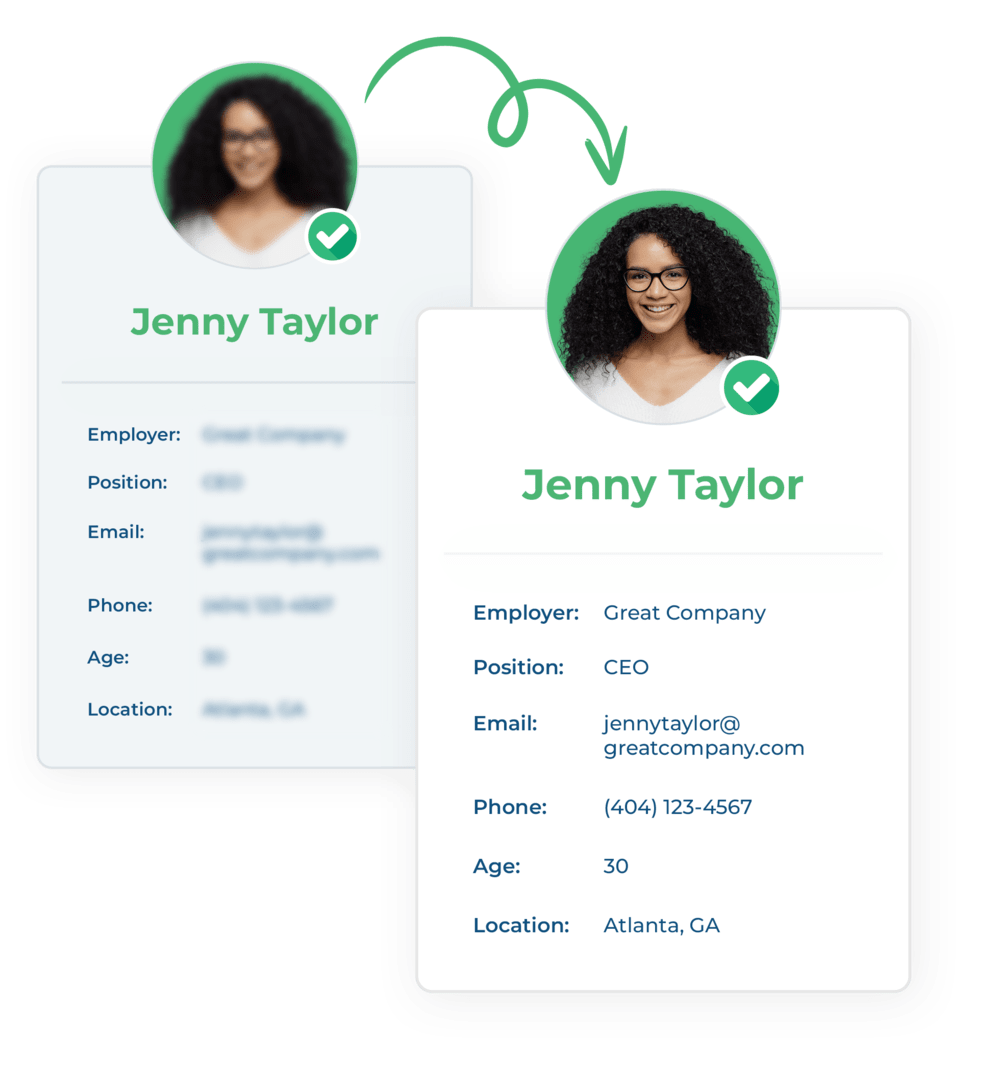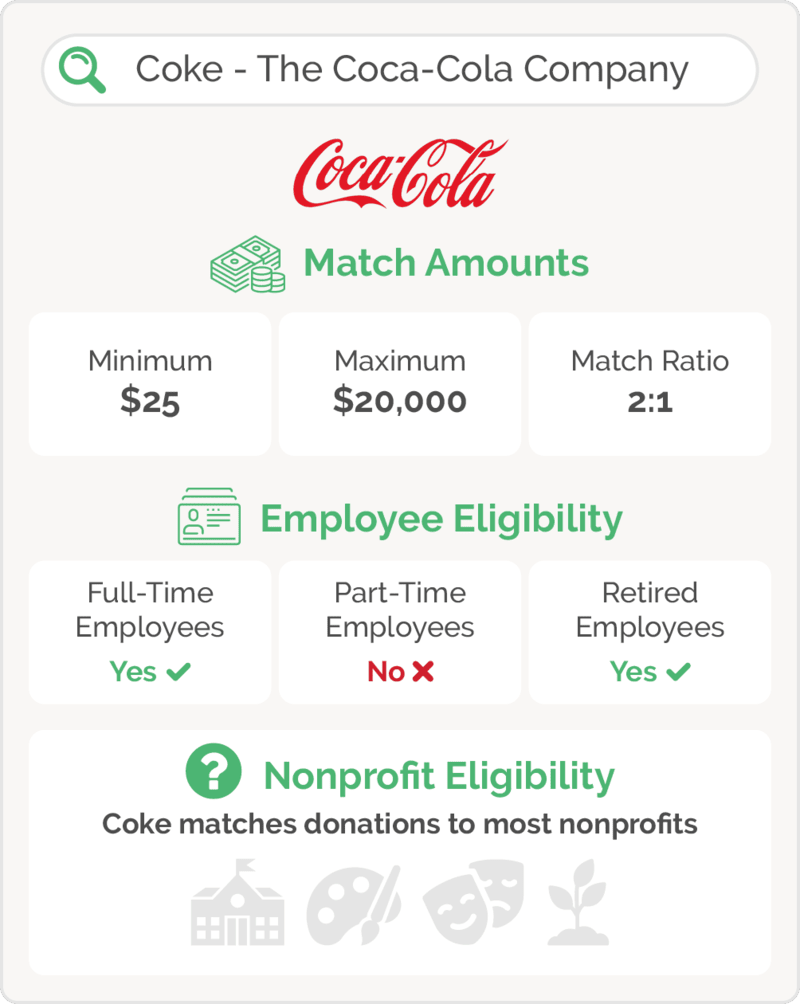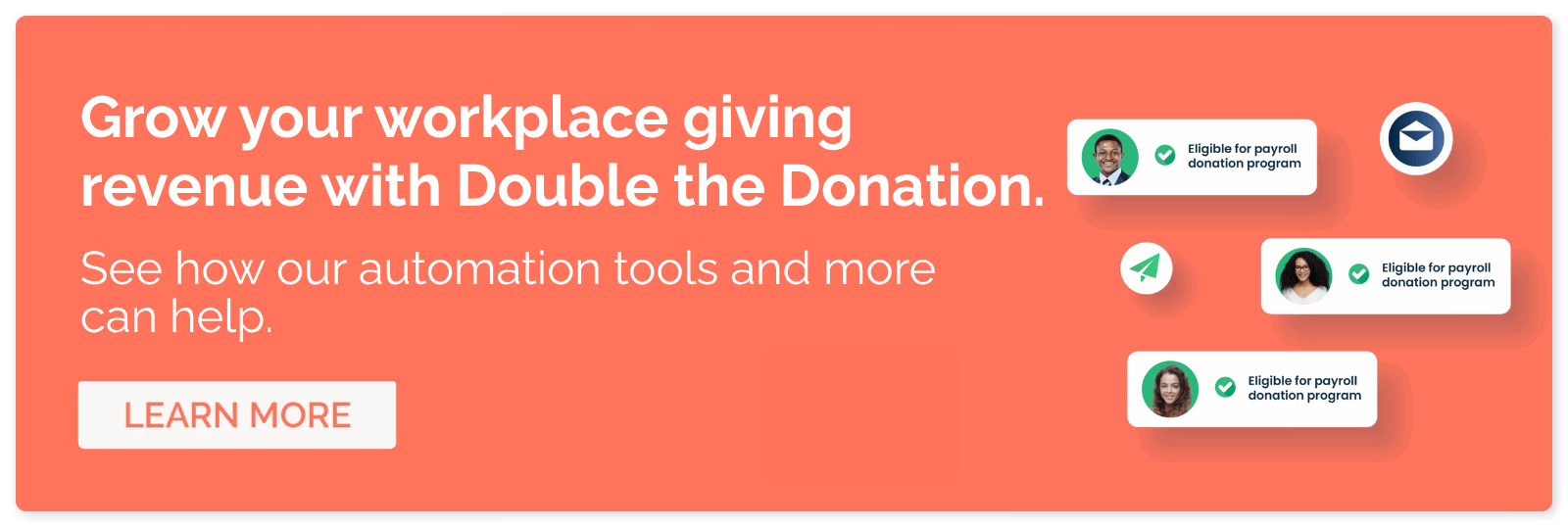Prospect Research: A Nonprofit’s Key to Better Fundraising
If your nonprofit is looking for a way to maximize its fundraising efforts, there’s one avenue you might not be paying enough attention to: prospect research.
Regardless of your organization’s size, gathering the right donor data via prospect research can have a huge impact on your nonprofit’s revenue. These funds can help you serve your mission, fund important projects, and work toward your goals.
In this guide, we’ll outline several important pieces of information you’ll need to successfully leverage prospect research, including:
- The Basics of Prospect Research
- Employment Data: The Most Powerful Piece of Modern Fundraising Intelligence
- Other Data Points to Gather During Prospect Research
- Primary Uses of Prospect Research
- How Matching Gifts Can Aid in Prospect Research
- How to Research Donors and Other Constituents
- Types of Prospect Research Tools and Software
- Fueling Your Prospect Research With Double the Donation
From learning the basics to soliciting your first prospects, a thorough understanding of prospect research can be a game-changer for your organization. Let’s get started!
The Basics of Prospect Research
What Is Prospect Research?
Prospect research is a process performed by a nonprofit’s development team to gather data about donors, volunteers, and other supporters. The process analyzes each individual’s giving capacity, motivations, and affinity for the cause. It helps determine an individual’s ability and desire to support that specific cause, as well as how to appeal to their interests.
Key factors nonprofits look for during prospect research include past giving, wealth markers, business affiliations, and philanthropic tendencies. Nonprofits can also use software or turn to prospect research companies to gather this data.
Wealth Screening vs. Prospect Research
You may have heard the term wealth screening in conjunction with prospect research. While the two terms are often used interchangeably, wealth screening is only one component of prospect research.
Wealth screening analyzes a donor’s financial profile, including real estate and stock holdings, as well as political giving. While it’s an essential part of prospect research, this only indicates an individual’s ability to give.
Prospect research goes a step further and uses both wealth and philanthropic indicators to determine a donor’s willingness and capacity to give. This provides nonprofits with a complete picture of each donor and helps make more informed solicitations. We’ll explore the complete range of data you should collect in the next section.
Who Uses Prospect Research?
A variety of organizations use prospect research to boost revenue and drive more meaningful relationships. These include:
- Educational institutions: Thorough research can pinpoint alumni and parents with a strong financial capacity and a history of philanthropy. Educational institutions can then tailor fundraising appeals to promote scholarships, facilities upgrades, and special programs.
- Healthcare organizations: Prospect research helps identify donors with personal connections to specific medical causes or who have previously donated to health-related initiatives. This allows these organizations to focus on potential donors likely to fund state-of-the-art equipment or patient care facilities.
- Arts and cultural organizations: Arts organizations can identify patrons with a keen interest in the arts and a history of supporting cultural initiatives. This information is crucial for targeting campaigns for exhibitions, performances, and educational workshops.
- Environmental groups: These organizations can identify donors who are passionate about conservation, climate change, or specific regional environmental issues. Effective prospect research can lead to targeted campaigns that resonate deeply with donors’ values, driving funding for crucial projects and advocacy efforts.
- Faith-based organizations: Prospect research helps identify individuals who have shown generosity to religious or spiritual causes, enabling faith-based organizations, such as churches, to personalize solicitations for funding new facilities and mission work.
- Advocacy groups: Prospect research helps uncover supporters who are financially capable and deeply committed to specific causes like civil rights, education reform, or health policy. This insight helps mobilize resources for lobbying and public awareness campaigns.
- Greek organizations: Fraternities and sororities can use prospect research to connect with alumni who have fond memories of their membership and might be interested in funding scholarships and chapter house renovations.
Prospect research can help all of these organizations (plus others!) become more focused in their outreach.
The Value of Thorough Prospect Research
40% of B2B salespeople say prospecting is the most challenging part of the sales process. When it comes to fundraising, nonprofits experience that same exact pain point. Prospect research can be incredibly helpful in sourcing and qualifying leads to avoid wasting time pursuing individuals without the affinity or capacity to give.
Beyond time savings, here are the most important benefits of researching supporters:
- Improved Fundraising Efficiency: Prospect research helps nonprofits identify the most promising donors, focusing efforts on those who are most likely to contribute.
- Tailored Appeals and Marketing: By understanding potential donors’ giving capacity, nonprofits can tailor asks to different supporter segments based on individual wealth indicators and giving history.
- Better Supporter Relationships: Comprehensive prospect research enables nonprofits to understand supporters’ interests and passions, enabling personalized communication that resonates with each individual’s values and helps retain support.
- Strategic Planning: Insights into supporters’ capabilities and preferences help nonprofits plan their projects more effectively.
- Finding Your Next Challenge Match Leader: While many nonprofits view prospect research simply as a way to fill a pipeline with individual donors, the most strategic organizations use it to find partners. The ultimate win is identifying a high-capacity donor who is willing to leverage their gift as a Challenge Match to inspire other donors as well.
- More Reliable Data: Prospect research helps nonprofits gather comprehensive, accurate data on potential donors, including phone numbers, demographics, wealth indicators, and philanthropic interests. Reliable data is crucial for making informed decisions and staying connected with supporters.
Prospect research is essential for nonprofits looking to optimize their fundraising initiatives and build lasting relationships. Make sure you’re working with reliable tools and companies to gather supporter data, and you’ll set your team up for success.
Employment Data: the Most Powerful Piece of Modern Fundraising Intelligence
While real estate and stock holdings have traditionally been the “gold standard” of wealth screening, employment data has emerged as the single most valuable data point in modern fundraising.
Why? Because knowing where a donor works provides a dual layer of financial intelligence that no other data point can offer:
- It Reveals Immediate Capacity: Job titles and employers are direct proxies for income and disposable assets. A Director at a Fortune 500 company or a Partner at a major law firm signals immediate major gift potential without needing to dig through property tax records.
- It Unlocks Corporate Wallets: This is the hidden value. Employment data tells you exactly which donors are eligible for matching gifts, volunteer grants, and even sponsorship programs. When you identify a donor who works for a workplace giving company, you are effectively identifying a donor whose gift can be instantly doubled or tripled, with even greater partnership potential down the road.
In today’s landscape, employment data is the bridge between individual giving and corporate philanthropy. By prioritizing employment information in your prospect research, you aren’t just assessing a donor’s personal checkbook; you are assessing their ability to direct corporate funds to your mission.
Other Data Points To Gather During Prospect Research
Since prospect research involves collecting both wealth and philanthropic indicators, it’s important to understand the common data points under each umbrella.
1) Philanthropic Indicators
Philanthropic indicators represent an individual’s willingness to give to your organization. These include:
Previous Donations to Your Nonprofit
Past giving is the best indicator of future giving because it means the supporter is interested in your cause and has already contributed. Prospect research helps uncover prior donations so your organization can reach out again.
Donations to Other Organizations
If your donors are philanthropically minded, they probably aren’t only giving to your nonprofit. Let prospect research unveil past giving to organizations with causes similar to yours.
Nonprofit Involvement
Giving isn’t the only indicator of an individual’s philanthropic mindset. With prospect research, you can identify other forms of nonprofit involvement, such as advocacy, volunteerism, and board membership.
Personal Information
Collecting personal data will give you a more holistic understanding of each donor and how to connect with them on a deeper level. Craft more targeted appeals and deliver those appeals successfully by gathering this donor data:
- Full and preferred name and title
- Gender
- Marital status
- Contact information, like email addresses, phone numbers, and postal addresses
- Hobbies and interests
- Dates of birth
Much of this information can be collected online or through data appending services, helping you identify ideal prospects.
2) Wealth Indicators
Wealth indicators represent an individual’s ability to give to your organization. These include:
Real Estate Ownership
The quality and quantity of real estate someone owns are wealth indicators your fundraising team should pay attention to. Individuals with notable real estate have large giving capacities that you can capitalize on in your nonprofit’s fundraising initiatives.
Business Affiliations
Prospect research can help you detect existing business connections among your donors. This research includes details about a donor’s career, such as salary estimates, which can indicate wealth and ability to give. You may also discover information about a donor’s employer’s corporate giving program, which can provide insights into potential matching gift opportunities.
Stock Ownership/SEC Transactions
Knowing about a contributor’s stock ownership can give you even more insight into their wealth and capacity to donate to your organization.
Political Contributions
Chances are that an individual who has made sizable donations to a political campaign also has the giving capacity to donate major gifts to your nonprofit. By using prospect research to target this group, you can focus on winning over prospects with the potential to make generous contributions.
Primary Uses of Prospect Research
Prospect research can impact several areas of your mission. Let’s explore common ways nonprofits use the data they gather.
Major Giving
Prospect research is the perfect tool for identifying major gift prospects hidden in your existing donor database. It can help you uncover past giving and involvement and track giving patterns that may predict major giving.
For instance, you might have a faithful donor whose contributions have steadily increased over the past five years. With prospect research, you can examine that donor’s history and figure out the best strategy to ask for a major donation.
Capital Campaigns
A capital campaign is a long-term fundraising effort that’s usually tied to a large project, such as the construction of a new building or the development of an endowment.
Capital campaigns typically rely on a set number of major gifts during the “quiet phase” before fundraising is opened to everyone in the “public phase.” Prospect research can help uncover ideal donors for both the quiet and public phases.
Challenge Matches
A challenge match (wherein a major donor pledges a large sum contingent on the nonprofit raising an equal amount from other supporters) creates urgency and excitement. Prospect research can be vital for identifying a lead donor for this strategy by uncovering individuals who not only have high financial capacity but also a leadership profile and deep affinity for the cause.
Identifying these “Challenge Match Leaders” is a powerful way to turn a single major gift into a revenue multiplier for your entire campaign, far exceeding the value of a standard one-time donation.
Annual Giving
Annual giving is what keeps your organization’s wheels turning. Without it, you wouldn’t be able to complete your day-to-day operations.
While your organization likely already asks all supporters to contribute to your annual fund, you can now search for new annual donors via prospect research tools. In addition, you’re more likely to uncover potential supporters by looking into someone’s past giving to organizations that align with your own.
Corporate Giving Opportunities
Prospect research is instrumental in identifying and understanding potential corporate partners whose philanthropic interests align with your nonprofit’s mission. Collecting employer data also helps pinpoint untapped opportunities. Examples include:
- Matching gifts: Many companies match their employees’ donations to eligible nonprofits. Knowing where your supporters work can help you identify match-eligible donors, so you can follow up and double those individuals’ contributions.
- Volunteer grants: Businesses also provide volunteer grants to nonprofits where their employees volunteer regularly. Prospect research can help pinpoint these opportunities.
- Volunteer Time Off: Tons of companies offer their employees bonus PTO to participate in volunteer activities with organizations like ours. Use prospect research to identify volunteers (or prospects) who work for companies with these programs.
- In-Kind Donations: Companies can provide non-monetary support in the form of goods or services. Prospect research helps identify potential donors who can offer in-kind contributions relevant to your nonprofit’s needs, such as technology, office supplies, or professional services.
Once you identify these opportunities, your nonprofit can reach out to supporters who are eligible to participate in their companies’ corporate giving programs.
Planned Giving
Identify donors who are in a position to make significant long-term commitments, such as bequests, trusts, or annuities.
Researching a donor’s financial background and giving history enables your nonprofit to tailor conversations about legacy opportunities that resonate on a personal level, helping you secure future funding and ensure the donor’s lifelong engagement with your mission.
How Matching Gifts and Prospect Research Work Together
Matching gifts and prospect research are both powerful strategies that, when combined, can significantly enhance your fundraising efforts.
As mentioned, prospect research helps identify donors who are affiliated with companies that offer matching gift programs, potentially doubling their donations without requiring extra effort from the donors themselves. This synergy not only boosts your fundraising capacity but also deepens donor engagement, as donors feel their contributions have a greater impact.
Here are some key ways that matching gifts and prospect research can work together to dramatically increase your fundraising success:
- A matching gift search tool can help you identify corporate and individual prospects from a list of people who have already made matching gifts to your nonprofit.
- Matching gifts can encourage prospects to give more to your organization by inspiring them to double their impact. In fact, one in three donors is more likely to donate if a match is offered.
- Prospect research and matching gifts can grow your corporate engagement efforts by pinpointing companies with generous programs.
- Focusing on individuals with matching gift potential doubles the value of that donor’s potential support.
To manage this strategy effectively, consider using specialized tools like Double the Donation Matching. This software simplifies tracking and verifying matching gift eligibility and submissions, ensuring you make the most of every donation opportunity.
How to Research Donors and Other Constituents
Once you’ve decided to perform prospect research, you might be wondering where you should start. Here are the general steps you can take to gather supporter data.
1) Choose your prospect research method.
Your first step is to plan how you’ll approach your research process by asking yourself about your fundraising goals, current strategies, and timeline. Once you understand what you need out of your research, choose one of these methods:
- Do It Yourself: For smaller or newer nonprofits with tighter budgets, a do-it-yourself prospect screening approach is a good option. Use free or low-cost prospect research tools to examine donors’ giving and philanthropic histories.
- Prospect Research Consultants: Prospect research consulting firms are extremely valuable resources for nonprofits. They offer advice and comprehensive screenings for nonprofits of all shapes and sizes.
- Prospect Screening Companies: Every prospect screening company is different, but most compare your donors against a variety of databases to create a comprehensive profile for each supporter. This will help your organization track, sort, and evaluate all of your supporters.
Make sure you know exactly which data you need to collect and how quickly you need to collect it, so you can pick the right method.
2) Form a prospect research team.
If you’ll conduct prospect research in-house, you’ll need to build an effective prospect research team of individuals with complementary skills. The following roles are critical to your team’s success:
- Director: This individual leads the team, sets strategic goals, and ensures alignment with your nonprofit’s broader objectives. They oversee the entire research process and ensure the team has the necessary tools to conduct research.
- Prospect Researcher: This team member is responsible for gathering data about potential and current supporters. They’re tasked with creating detailed profiles by digging into donor data using various sources, such as databases, public records, and social media.
- Data Analyst: A data analyst focuses on interpreting data and trends from donor databases and external sources. They help the team understand giving patterns and identify potential high-value donors.
- Development Officer: This individual uses insights from prospect research to cultivate and maintain donor relationships. They are typically involved in direct fundraising efforts and use data-driven strategies to approach potential donors, secure donations, and nurture ongoing donor relationships.
- Legal/Compliance Officer: Given the sensitive nature of handling personal data, having someone knowledgeable about legal and ethical standards is crucial. This team member ensures that all prospect research activities comply with privacy laws and ethical fundraising practices.
Each role focuses on a specific aspect of the prospect research process, contributing to a comprehensive approach. While the structure of your team may vary, this suggested structure supports targeted fundraising efforts and helps build a robust foundation for long-term supporter engagement.
3) Clean up your data.
Before conducting prospect research, clean up your data to ensure the process runs smoothly and yields more accurate results. A few ways to maintain proper data hygiene include:
- Identifying and removing duplicate records within your database
- Standardizing data entries to maintain consistency across your database, such as by using uniform formats for dates, addresses, phone numbers, and names
- Identifying and removing outdated or irrelevant information that no longer serves your fundraising strategies
- Removing lapsed donors from your records
- Scanning your database for typos
Your data doesn’t need to be perfect, but cleaning it up as much as possible will optimize your system for prospect research.
4) Check for accuracy.
Once you’ve actually conducted prospect research, verify the accuracy of the data gathered. This step involves cross-referencing information from multiple sources to confirm details such as contact information, philanthropic history, and financial capacity. Some prospect research companies will have an accuracy-check process, such as manually verifying appended emails and phone numbers.
Ensuring data accuracy helps prevent miscommunication and fosters trust by demonstrating diligence and respect for each prospect’s information. It also optimizes the efficiency of subsequent outreach efforts by reducing the time spent on addressing inaccurate or outdated information.
5) Analyze and make a plan for leveraging your new data.
After integrating the new data into your CRM, be sure to sift through the results to identify the most promising prospects by analyzing factors such as giving capacity, alignment with your nonprofit’s mission, and likelihood of giving. Based on this analysis, create a detailed plan for how to best use this data for outreach.
This plan should outline who to approach, the best ways to reach out to them, and the right time to do so. It involves deciding whether to meet someone in person, invite them to a special event, send them a personalized letter, or connect through online platforms based on their preferences and past donations.
During this stage, you’ll want to segment your supporters based on shared characteristics.
These may include:
- Donation Level: Group donors based on the amount they contribute, such as major, mid-level, and low-level donors. This allows for tailored communication strategies that recognize the level of support.
- Workplace Giving Eligibility: Targeting donors who qualify for matching gifts, volunteer programs, or payroll giving is a great way to make the most of your supporters’ uncovered connections. Be sure to use the information you’ve gathered (such as employer name and program guidelines) to further personalize your outreach.
- Donation Frequency: Identify who gives regularly versus those who donate sporadically. Regular givers can be approached for recurring giving programs, while sporadic givers can be encouraged to give more consistently.
- Geographic Location: Segmenting donors by location can help organize local events, understand regional interests, and tailor communications that resonate with local community values or needs.
- Interests: By understanding what specific projects or aspects of the organization’s work a donor supports, nonprofits can tailor outreach to reflect donors’ interests.
- Type of Support: Differentiate between types of supporters such as volunteers, advocates, corporate sponsors, and individual donors.
- Demographics: Segmenting based on demographics helps choose messages and outreach strategies that are more likely to resonate with different groups.
- Communication Preferences: Some supporters may prefer digital communication, while others might value traditional mail or personal calls. Segmenting by communication preference ensures supporters receive information in the way that is most accessible and engaging to them.
An effective plan ensures your team knows exactly what steps to take to engage each prospect, turning potential interest into actual support. From here, put your plan into action and start reaching out!
Types of Prospect Research Tools and Software
While the prospect research process may sound daunting, there are several prospect screening companies and platforms that nonprofits and educational institutions can use. Let’s explore a few recommended services and tools.
Data Enhancement
Also called data appending companies, data enhancement services improve the quality and depth of existing donor databases by pulling additional information, such as:
- Contact information like email addresses, postal addresses, and phone numbers
- Demographics like ages, birthdates, and geographic location
- Employer data like company names and role titles
These services leverage external data sources to fill in gaps and update outdated information within your database. This ensures your nonprofit has accurate, comprehensive profiles for each prospect.
Prospect Research Database
Prospect research databases are specialized tools that provide access to a wealth of information on potential donors, including personal backgrounds, giving histories, wealth assessments, and affiliations.
These databases compile data from multiple public and proprietary sources, allowing fundraisers to quickly gather detailed insights about prospective donors’ capacity and propensity to give. Using this type of prospect research tool helps nonprofits identify and prioritize high-potential prospects.
Corporate Giving and Prospecting Software
Corporate giving software is designed to help nonprofits identify potential corporate donors. This type of software typically includes features for researching matching gift programs and volunteer grant information. Here are two types of tools that are most helpful:
- Matching gift databases contain information on companies that offer matching gift programs. They store requirements for employee eligibility, nonprofit eligibility, and donation amounts. Plus, they provide relevant submission information such as available forms and deadlines.
- Volunteer grant databases provide details on companies that offer grants to nonprofits where their employees volunteer. This prospect research tool stores records of individual companies’ programs, including volunteer hours, employee and nonprofit requirements, and instructions, along with links to application forms and deadlines.
Additionally, corporate prospecting software like Double the Donation leverages existing donor data to uncover hidden corporate potential. By uploading your current donor list for a quick employer append screening, the platform instantly identifies which of your supporters are eligible for workplace giving opportunities that can significantly grow your organization’s revenue. This transforms your standard donor list into a high-value prospect list, allowing your team to prioritize outreach to donors whose contributions can be immediately doubled, maximizing both individual donor value and overall fundraising efficiency before a major gift ask is even made.
These prospect research tools can help your nonprofit identify donors and volunteers eligible for their companies’ philanthropic programs. Plus, they can help you identify companies that offer generous corporate giving initiatives, which can open the door to strategic partnerships.
Donor News Alert Services
Donor news alert services are platforms that monitor and report news about prospective donors. Your nonprofit can use a platform like this to stay informed about donor activities that signal a willingness or ability to give. Even more importantly, these insights help nonprofits build deep, meaningful relationships with their donors, which may yield significant gifts in the future.
For example, these platforms monitor obituary data, meaning they can notify your nonprofit when a prospect or donor’s loved one passes away. Your fundraising team can then reach out with heartfelt condolences on behalf of your organization. Prospects will likely appreciate this personal outreach and attention to detail, and may be more willing to support your organization in the future.
Insightful Philanthropy is our recommended donor news alert service for its extensive information sourcing and timely notifications. This platform relies on 14,000 news and information sources from more than 200+ countries, and even taps into historical donor data from up to 40 years ago to give nonprofits a complete picture of their prospects.
Your Nonprofit’s CRM
Your nonprofit’s CRM is a fundamental tool for managing donor interactions and tracking engagement history. It stores critical data such as donation records, event attendance, volunteer activity, and communication preferences, which can be leveraged to build stronger relationships with supporters.
Effective use of a CRM helps personalize donor interactions and streamline fundraising activities, making it easier to cultivate and steward donor relationships.
SEC Investment Records
SEC investment records provide information about the investment activities of individuals and institutions, which can be particularly valuable in assessing the financial capacity of potential major donors.
By examining public filings such as insider trading reports and stock holdings, nonprofits can gauge prospects’ wealth level and philanthropic capacity. This is especially useful for identifying high-net-worth individuals and understanding their investment behaviors.
Predictive Modeling Solutions
Predictive modeling solutions use statistical techniques and algorithms to analyze historical data and predict future donor behaviors. These tools help nonprofits anticipate which prospects are most likely to donate, their expected donation amounts, and optimal times for solicitation.
Wealth Screening Tools
These tools help nonprofits assess potential donors’ financial capacity by analyzing data points such as real estate ownership, stock holdings, past charitable contributions, and other publicly available financial information. That way, you can focus on prospects with the means and propensity to give significantly.
As a top recommended prospect research service, DonorSearch blends philanthropic and wealth metrics so your organization can make informed decisions about prospects and plan effective outreach. Plus, the company offers a few choices of tools when it comes to conducting prospect research:
- Charitable giving database. DonorSearch’s charitable giving database is comprehensive and constantly growing, housing tons of useful philanthropic data.
- DSGiving search tool. DSGiving is a free prospect research tool that offers access to a smaller-scale version of DonorSearch’s philanthropic and political contributions data. Simply type in an individual’s name, state of residence, and gift type, and the tool will pull useful data.
DonorSearch helps your nonprofit learn more about your donors and create comprehensive donor profiles. Because the tools analyze philanthropic and wealth indicators, they yield more qualified leads for nonprofits to pursue.
Fueling Your Prospect Research With Double the Donation
Double the Donation is a leading fundraising tool for nonprofits, providing a range of matching gift solutions. Our complete automation platform can give your nonprofit the ability to maximize donations with matching gifts, volunteer grants, payroll giving, and more without lifting a finger.
Here’s an overview of our solution:
- Double the Donation Matching: Using Double the Donation’s matching gift fundraising software, organizations can uncover valuable matching gift prospects by collecting employer information within the donation process. From there, the solution screens for matching gift eligibility and populates the appropriate forms and guidelines for submitting a match. Plus, Double the Donation Matching offers a real-time employer appends add-on that instantly scans donor records and automatically supplies company information if available. Check out this video for a closer look:
- Double the Donation’s Workplace Giving Insights: This powerful new module takes your donor list and provides in-depth prospect research data focused solely on corporate giving potential. It screens donors’ employer affiliations to reveal which companies offer matching gifts, volunteer grants, and other workplace giving programs, transforming a scattering of individual donors into a prioritized list of corporate revenue opportunities.
Want to learn more about how our cutting-edge technology can support your prospect research and drive greater fundraising results? Reach out to our team for a free demo to see the complete platform in action!
Wrapping Up
Prospect research is an invaluable strategy that equips nonprofits with the insights needed to target donors effectively. By harnessing the power of detailed data analysis and strategic donor segmentation, your organization can unlock new opportunities and maximize the impact of its fundraising efforts.
If you’re looking for more information about prospect research, check out the additional resources below:
- Top 15 Prospect Research Tools for Clever Fundraisers. Interested in getting started with innovative prospect research solutions that can help power your next initiative? Check out this list of our top recommendations.
- Prospect Research and Matching Gifts: The Inside Scoop. Learn more about how prospect research and matching gifts go hand-in-hand. Discover key insights and best practices for making the most of these two opportunities.
- How to Collect, Manage, and Use Your Nonprofit’s Donor Data. Are you getting the most out of your nonprofit’s donor data? Here’s what you can do to maximize your organization’s data-driven fundraising potential.






